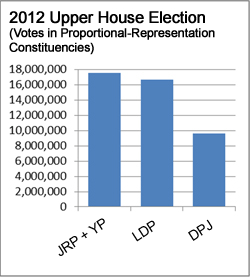Top>Opinion>One Perspective on the Results of the 2012 Lower House Election
 Index
Index

Masaru Miyano [profile]
One Perspective on the Results of the 2012 Lower House Election
Masaru Miyano
Professor, Faculty of Letters, Chuo University
Areas of Specialization: Socio-informatics, social research methods, political sociology
Japan's 46th general election -the election for the House of Representatives- was held a few days ago, on December 16, 2012. While various studies must be conducted before a detailed analysis can be made, I will try to offer one perspective on the election, based on factors of particular interest from the election results. These factors can be divided into four major themes: 1) Did the Liberal Democratic Party (LDP) really win; 2) Did the "wind" blow in the direction of the "third force"; 3) Did non-voters influence the election results; and 4) The future of democracy.
1) Did the LDP Really Win?
The interpretation of the election results as a "landslide victory for the LDP" seems to be widespread. In reality, however, it is not so easy to distinguish the winners from the losers in elections. This is due to the ambiguity surrounding the "standards" for winning and losing in an election. In the 1998 Upper House election, for example, the LDP was said to have suffered a "crushing defeat," leading to the resignation of Prime Minister Hashimoto after the election. Yet, in terms of total number of seats, one could say there was "not much difference" between the results of this election and those of the 1995 Upper House election (46 newly elected members in 1995 vs. 44 in 1998). Thus, the question of whether or not there was a "crushing defeat" depends on the standard of comparison that is used (for example, the magnitude of the expectations for the party before the election).
In the 2012 Lower House election, the LDP won 294 (61.3 percent) of the 480 seats. This was a "landslide victory" for the party in the sense that they won a clear majority of the total membership of the House of Representatives. Most impressively, the party won 237 (79.0 percent) of the seats in the single-seat constituencies.
On the other hand, the LDP obtained only 31.7 percent of the seats and 27.6 percent of the vote in the proportional-representation constituencies. Despite the fact that the LDP came out as the dominant party in this election, these figures are practically the same as the ones for the last Lower House election, in 2009, when the LDP won 30.6 percent of the seats and 27.6 percent of the vote in the same constituencies, yet experienced a "crushing defeat." One could say that the LDP's inability to win even one third of these votes or seats indicates the party's failure to capture the "will of the people" in the proportional-representation constituencies.
So, if the LDP had a "landslide victory" in the single-seat constituencies and a "crushing defeat" in the proportional-representation constituencies, did it win or lose the election? The usual approach is to view the election as a "landslide victory" due to the fact that the party secured a stable majority of seats. However, one could just as well reason that "the election results for the proportional-representation constituencies directly reflect the will of the people with respect to the political parties;" thus, as far as the "will of the people" is concerned, we must not ignore the election results for the proportional-representation constituencies. Taken as a whole, then, the 2012 election results cannot be interpreted as a straightforward victory for the LDP.
2) Did the "Wind" Blow in the Direction of the "Third Force"?
There is a view that the "third force," which attracted attention in the 2012 election, resulted in a "flood" of candidates from different parties, confusing voters and preventing the "wind" from blowing in a definite direction. There may be a difference of opinion over what forces actually constitute the "third force," but let us interpret it here as the JRP (Japan Restoration Party), the YP (Your Party) and the TPJ (Tomorrow Party of Japan).
It is thought that the election turned out badly for the "third force" due to the steep drop in voter turnout that ensued and the comparatively fewer number of organized votes these parties could count on. However, when we look at just the election results for the proportional-representation constituencies, the combined votes won by the JRP and YP alone account for 29.1 percent of the total votes cast-more than the votes obtained by the LDP (see Figure 1). The fact that more people voted for the JRP and YP parties than for the LDP is no small matter (if we add the votes for the TPJ to those for the JRP and YP, the percentage increases further to 34.8 percent). According to Figure 1, the results of the election made the "third force" the primary force, the LDP the secondary force, and the DPJ the tertiary force.
Thus, when we look at the election results in the proportional-representation constituencies, it seems that the "wind" did blow quite forcefully in the direction of the "third force" as a whole. The fact that the "third force," as a whole, was able to garner that many votes despite the low voter turnout is, I believe, remarkable. These votes were won despite a pervasive wariness that people were "growing tired" of new political parties and "distancing" themselves from them. To my mind, these results indicate the magnitude of voters' disappointment with the established political parties.

Figure 1: Number of votes obtained in proportional-representation constituencies in the 2012 Lower House election
3) Did Non-Voters Influence the Election Results?
Voter turnout was 59.31 percent-about ten percent less than the turnout for the last general election in 2009 and the "lowest postwar turnout." Still, however, this figure is not that different from the 59.65 percent turnout for the 1996 Lower House election and the 59.86 percent turnout for the 2003 Lower House election. The ten percent drop in voter turnout means that approximately ten million voters decided not to vote in this election. This is another significant figure.
Imagining what might have happened if these people had voted makes for an interesting thought experiment. If we estimate that many of the non-voters were undecided and refer to the voting behavior of undecided voters recorded in media exit polls (and imagine that the "third force" nominated a joint candidate for each of the 300 single-seat constituencies and succeeded in reducing voters' "confusion"), it is possible that no one could have predicted how any of the seats in the Lower House would have been distributed. (Whether this would have been a good thing or a bad thing depends on your viewpoint.)
4) The Future of Democracy
If there was no shortage of excellent politicians and political parties, voters would be able to relax and enjoy their lives, as in the utopia described in Laozi, even if they were indifferent toward politics. Democracy, however, does not work that way. The behavior of voters is reflected in politics in diverse ways. Not voting is one form of behavior-like it or not, we live politics. Voters may be disappointed with both the established and new political parties, but they have the power to "cultivate" them into the kinds of parties they want. Voters can also improve the quality of campaign promises by refusing to vote for parties that make "unfeasible promises," which lack sufficient funds, etc. The response of voters as a whole will have a profound influence on the future of democracy in Japan.
I have paid close attention to voter turnout by age group, but these figures are still unclear for the 2012 election. Voter turnout by age group for each election from the 31st Lower House election onward can be found at the website for the Association for Promoting Fair Elections (Available at: http://www.akaruisenkyo.or.jp/070various/071syugi/693/ [Accessed Dec 21, 2012]). According to this data, when voter turnout was low in the Lower House elections of 1996 and 2003, the turnout for voters in their twenties averaged about 36 percent (while the turnout for voters in their sixties averaged 78 percent). Meanwhile, when voter turnout was high in the Lower House elections of 2005 and 2009, the turnout for voters in their twenties increased to an average of around 48 percent (while the turnout for voters in their sixties averaged 84 percent). It will be interesting to see how the figures played out for the 2012 election.
We expect politicians to stay focused on the future of Japan and care about the lives of young people. However, politicians must find a way to win elections and may be driven to prioritize policies aimed at the elderly when voter turnout among young people is low. Figuring out ways to get more young people to participate in elections seems to be a major challenge in Japanese politics.
- Masaru Miyano
Professor, Faculty of Letters, Chuo University
Areas of Specialization: Socio-informatics, social research methods, political sociology -
Professor Miyano is from Kanagawa Prefecture. He was born in 1952. He graduated from the Faculty of Law, University of Tokyo in 1975.
He earned a master's degree in sociology from the Graduate School of Social Sciences, University of Tokyo and left the university in 1982 before completing his doctorate.
He worked as an assistant for the Faculty of Letters, Hokkaido University; a full-time lecturer at the Research Institute of Civilization, Tokai University; and an assistant professor on the Faculty of Letters, Chuo University, before assuming his current position in 1994.
His is currently researching social and political awareness (especially public opinion regarding politics, elections and public finance) and working to explain the relationship between these forms of awareness and the state of society.
His major publications include Basic Research on Elections [Senkyo no Kisoteki Kenkyu] (Chuo University Press, 2009), which he both authored and edited.
- Research Activities as a Member of Research Fellowship for Young Scientists (DC1), Japan Society for the Promotion of Science (JSPS) Shuma Tsurumi
- Important Factors for Innovation in Payment Services Nobuhiko Sugiura
- Beyond the Concepts of Fellow Citizens and Foreigners— To Achieve SDGs Goal 10 “Reduce Inequality Within and Among Countries” Rika Lee
- Diary of Struggles in Cambodia Fumie Fukuoka
- How Can We Measure Learning Ability?
—Analysis of a Competency Self-Assessment Questionnaire— Yu Saito / Yoko Neha - The Making of the Movie Kirakira Megane








